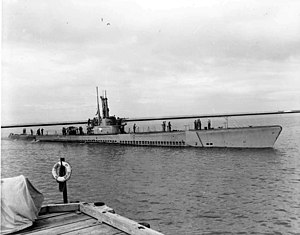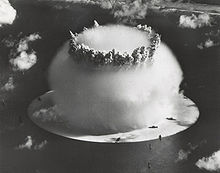USSApogon
 USSApogon(SS-308) heads towards dock at Submarine Base 5.
| |
| History | |
|---|---|
| Builder | Portsmouth Naval Shipyard,Kittery, Maine[1] |
| Laid down | 9 December 1942[1] |
| Launched | 10 March 1943[1] |
| Commissioned | 16 July 1943[1] |
| Decommissioned | 1 October 1945 |
| Stricken | 25 February 1947[2] |
| Fate | Used as a target for theOperation Crossroadsatomic bomb teston 25 July 1946, and sunk[1] |
| General characteristics | |
| Class and type | Balaoclassdiesel-electricsubmarine[2] |
| Displacement | 1,526tons(1,550t) surfaced,[2]2,391 tons (2,429 t) submerged[2] |
| Length | 311 ft 6 in (94.95 m)[2] |
| Beam | 27 ft 3 in (8.31 m)[2] |
| Draft | 16 ft 10 in (5.13 m) maximum[2] |
| Propulsion |
|
| Speed | 20.25kn(37.50 km/h) surfaced,[3]8.75 kn (16.21 km/h) submerged[3] |
| Range | 11,000 nmi (20,000 km) surfaced @ 10 kn (19 km/h)[3] |
| Endurance | 48 hours @ 2 kn (3.7 km/h) submerged,[3]75 days on patrol |
| Test depth | 400 ft (120 m)[3] |
| Complement | 10 officers, 70–71 enlisted[3] |
| Armament |
|
USSApogon(SS-308),aBalao-classsubmarine,was a ship of theUnited States Navynamed for theapogons,a genus of cardinalfishes found in tropical and subtropical waters. The original name planned for the ship wasAbadejo,but the name was changed on 24 September 1942 before the keel was laid down.
Construction and commissioning
[edit]Apogonwaslaid downon 9 December 1942, by thePortsmouth Navy YardinKittery, Maine;launched on 10 March 1943; sponsored by Mrs. Helen Lorena Withers (née LaBar), wife ofAdmiralThomas Withers, Jr., then Commander of Submarine Forces; and commissioned on 16 July 1943.[citation needed]
Service history
[edit]World War II
[edit]The submarine held shakedown in the waters off theNew Englandcoast and departedNew Londonon 13 September, bound forHawaii.Apogontransited thePanama Canalon 25 September and reported for duty on that date to the Commander in Chief,Pacific Fleet.She reachedPearl Harboron 11 October and began three weeks of training.[citation needed]
After loading fuel and provisions,Apogongot underway on 3 November for her first war patrol. Her patrol area comprised the waters within a 60-mile (110 km) radius ofMoen Islandand those along the shipping lanes betweenTrukandKwajalein.The submarine was acting in support ofOperation Galvanic,the seizure of theGilbert Islands.
After a brief stop atJohnston Islandon 5 November to top off her fuel tanks,Apogoncontinued on to her assigned area. During this patrol, she sighted four contacts deemed worthy of torpedo expenditure and actually attacked three. The only major damage she inflicted occurred on 4 December, when the submarine sankDaido Maru,a former gunboat. On 18 December, she ended her patrol and moored atMidway Atoll.
Following a refit there,Apogonproceeded to Pearl Harbor on 26 December for further repairs and training. She left Hawaii on 15 January 1944 for her second patrol, this time in waters surrounding theMariana Islands.On 1 February,Apogonmade the only attack of the patrol. She sighted a six-shipconvoyand, soon thereafter, opened fire. The crew heard an explosion and saw their torpedoed target burst into flames. Ten minutes later, the lookout saw about 50 feet of the Japanese ship's stern sticking out of the water, and this soon disappeared.Apogonthen attacked another Japanese auxiliary. AlthoughApogonclaimed to have sunk both ships, she was not officially credited with having destroyed either.Apogonended her patrol after 50 days and returned to Pearl Harbor on 9 March.
Apogonmoored besideBushnellon 10 March to commence refit. The submarine wasdrydockedat the Pearl Harbor Navy Yard from 15 to 19 March for the installation of two newpropellers.After additional training exercises, she got underway on 2 April.
She paused at Johnston Island on 4 April to refuel, and later that day resumed her voyage toward waters south of theJapanesehome islands. However, when a crewman was preparing to clean a 20 millimeter machine gun the next day, a live cartridge accidentally left in the chamber discharged and ricocheted into the man's leg.Apogonimmediately returned to Johnston Island to transfer the wounded man to the dispensary. The submarine again got underway on 6 April and conducted her entire patrol without encountering any enemy shipping. She finally arrived atMajuroon 22 May.
Refitting began on 23 May, and the submarine got underway on 8 June for trials.Apogonbegan her fourth patrol, which was in the area betweenFormosaand thePhilippines,in company withGuardfish,Thresher,andPiranha.
On 12 July,Apogonand herwolf packconsorts spotted a nine-ship Japanese convoy sailing with approximately six escorts. The submarines immediately began preparing an attack. The leading Japanese ship of the center column of the formation apparently sighted the wake ofApogon'speriscopeand turned back to ram the submarine. AsApogonwas turning to port to bring her stern tubes to bear, she was struck on the starboard side by the freighter. About eight feet of the main periscope and periscope shears were torn off, and theradarmasts were bent and put out of commission. As a result,Apogonprematurely ended her patrol to return for repairs. She arrived at Midway on 22 July, where crews installed additional bracing on the periscope shears before the submarine proceeded on to Pearl Harbor.
Having reached Pearl Harbor on 26 July,Apogonwas dry-docked. Both tail shafts were replaced and realigned, and the periscope, periscope shears, and the radar masts were replaced. The three main engines were also overhauled. On 12 September,Apogonwas underway on yet another wartime patrol. She headed for theKuril Islandsarea. The submarine then sunk a Japanese patrol craft on 23 September the 400 tonChoyo Maru No.6.[7]Four days later, she sankHachirogata Maru.Following this sinking, she rescued two Japanese survivors. The next month proved fruitless, andApogonarrived at Midway on 28 October, ending her fifth patrol.
After a month of refit,Apogoncommenced her sixth patrol on 20 November, again sailing for the Kuril Islands. The only action of this patrol was an attack on atanker,which the submarine hit and damaged with atorpedo19 December 1944.[7]On 5 January 1945,Apogonarrived in Pearl Harbor for a brief stay before getting underway on 7 January for theMare Island Naval Shipyard,Vallejo, Californiato undergo a major overhaul.
Apogonreturned to action on 28 May. Her patrol station was the Kuril Islands-Sea of Okhotskarea. She attacked a convoy of four Japanese ships and escort vessels on 18 June and sank one 2,614-ton transport,Hakuai Maruand sank the guard boatKusonoki Maru no.2.[7]On 2 July,Apogonseverely damaged two small auxiliary submarine chasers Cha 58 and Cha 65.[7]The patrol ended on 14 July at Midway.
Apogonbegan her eighth and final patrol on 7 August. She was assigned to theMarcus Islandarea. She made no attacks during this patrol because the Japanese capitulated on 15 August.Apogonreturned to Pearl Harbor on 2 September and then continued on toSan Diego,where she arrived on 11 September.Apogonwas placed in reserve and decommissioned there on 1 October.[citation needed]
Post-War
[edit]Operation Crossroads
[edit]
In January 1946, the submarine sailed for Pearl Harbor where she was to undergo preliminary work and tests in preparation to be used as a target inatomic bombtesting. Following completion of this refitting,Apogonarrived atBikini Atollon 31 May. She was sunk at Bikini during atomic bomb test "Baker"on 25 July 1946. Her name was struck from theNaval Vessel Registeron 25 February 1947.[citation needed]
Awards
[edit]Apogonreceived sixbattle starsfor herWorld War IIservice.
References
[edit]- ^abcdeFriedman, Norman (1995).U.S. Submarines Through 1945: An Illustrated Design History.Annapolis, Maryland:United States Naval Institute.pp. 285–304.ISBN1-55750-263-3.
- ^abcdefgBauer, K. Jack; Roberts, Stephen S. (1991).Register of Ships of the U.S. Navy, 1775-1990: Major Combatants.Westport, Connecticut:Greenwood Press. pp. 275–280.ISBN0-313-26202-0.
- ^abcdefU.S. Submarines Through 1945pp. 305–311
- ^abcdeBauer, K. Jack;Roberts, Stephen S. (1991).Register of Ships of the U.S. Navy, 1775–1990: Major Combatants.Westport, Connecticut:Greenwood Press. pp. 271–280.ISBN978-0-313-26202-9.
- ^U.S. Submarines Through 1945pp. 261–263
- ^abcU.S. Submarines Through 1945pp. 305–311
- ^abcdUboat forum
 This article incorporates text from thepublic domainDictionary of American Naval Fighting Ships.The entries can be foundhereandhere.
This article incorporates text from thepublic domainDictionary of American Naval Fighting Ships.The entries can be foundhereandhere.
External links
[edit]- Photo galleryofApogonat NavSource Naval History
- Kill Record: USSApogonArchived30 November 2015 at theWayback Machine
